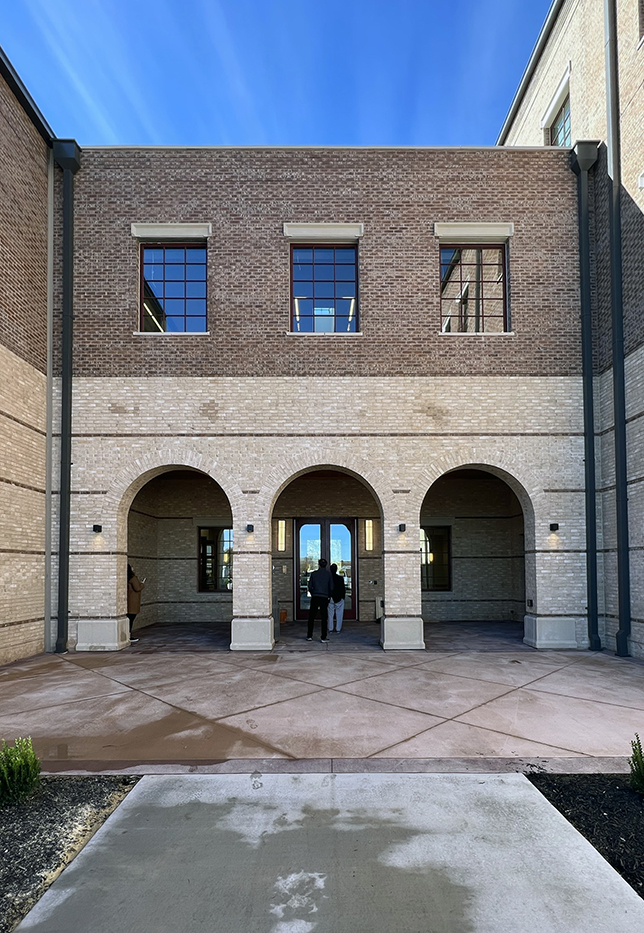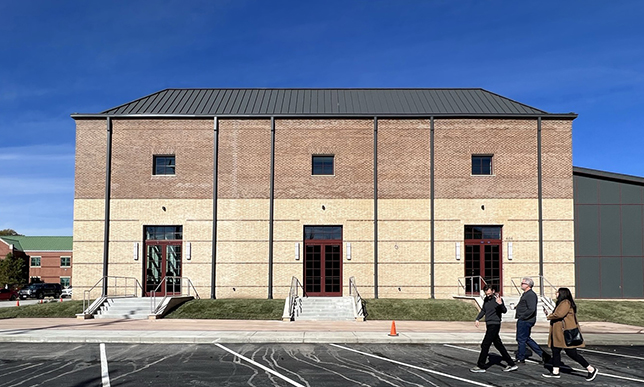Drury University’s Enterprise Center Created as Campus and Community Hub
By John R. Kirk
The Enterprise Center at Drury University, its first new building—and first major academic building—to be built in over 20 years, is a tripartite composition that contributes magnificently to its setting, to the fabric of the university, and to the fabric of the city of Springfield, Mo.
Conceived as a hub for the university and the community at large in which it resides, the Enterprise Center is appropriately positioned at the prominent intersection of Drury Lane and Central Street, Drury Lane being the literal and figurative spine of the university and Central Street an important historic street in Springfield that crosses through the university.
The intersection of Drury Lane and Central Street—the university’s cardo e decumanus, or primary north-south and east-west axes—is also a natural topographic crest, a high point for miles around. The building unfolds to the eye from many directions at great distances, revealing itself as a monument to the idea of interdisciplinary, collaborative, project-based learning.

Images courtesy of Cooper Robertson
The new structure will house Drury’s Breech School of Business Administration, Compass Center, international affairs offices, political science, mathematics, and computer science programs, as well as student success services, conferencing, food and beverage services, and social spaces. Most of its interior volumes are dedicated to areas for collaboration: students with other students; students with faculty; faculty with faculty; and local business leaders and community groups with Drury students, faculty, and staff.
The exterior architectural expression is cleverly contextual, with a richness of subtle detailing and materiality, including a dual palette of brick at the rusticated base where there’s a cream-colored brick with a blonde mortar in a Flemish bond pattern. Above, a darker, reddish brick is in a running bond pattern with a corbeled brick cornice, cast stone lintels, and sills.
It is elegant, dignified, and fresh. It is at once new and old; that is to say, it is timeless. Most importantly, it “fits.” It couldn’t be any other building in any other setting. In this way it is deeply rooted and unique, adhering to the “rules of place,” or the genus loci.
The massing and fenestration are further orchestrated by an array of other architectural elements and details, for example, the rhythm of rain leaders that help frame the carefully composed facades. The roofscape, with its mansards, gables, dormers, and other accentuating features, strikes a stunning figure on the skyline rivaling any in the region.

Punctuating all this is the entry tower that marks the intersection of Drury Lane and Central Street and rises 62 feet, with a pyramidal, ziggurat roof capped by a finial to become the tallest academic building on Drury’s campus in its 150-year history.
The entry tower is now the campus’ campanile, rotated slightly less than 10 degrees to orient itself to Drury’s Burnham Circle to the north, the historic heart of the campus, thereby connecting old and new.
Curtain walls with cast stone surrounds are windows to the world in two of the building’s three primary spaces: the three-story atrium in the main body of the building, and the ballroom that is the primary volume in the executive conference center, which seats 477.
The third of the three most important rooms in the new complex, the trustees’ boardroom, is the lynchpin between the Enterprise Center and the executive conference center, joining the two with a vaulted ceiling to a glazed monitor bringing in natural light from above to complement the generosity of windows on its east and west facades.

The Enterprise Center is a “wolf in sheep’s clothing” in that it is contextual and familiar on the outside, while being intoxicatingly contemporary inside. The interiors are an explosion of light, views, and grandeur, with some 3,600 square feet of interior glazing. Modern and state-of-the-art in every way (and supported by more than 13 miles of cable throughout the building), the spaces celebrate both the structural steel tectonics of the building and its programmatic offerings and activities. Amenities include a trading floor, cybersecurity laboratory, mediascape rooms with green screens, a design laboratory, and a plethora of places designed to encourage collaboration.
Finally, a grand stair, complete with a “moon pod”—designed as a cantilevered balcony overlooking the atrium where students, faculty, and visitors can gather—is a visual, vertical ribbon that angles from north to south and connects all three floors within the atrium volume.
In fact, the new edifice is all about making connections. On an urban level, it connects the context of the university and the city, Central Street and Bob Barker Boulevard. With the rotated entry tower, it connects to Burnham Circle and Drury’s rich history. It also connects Drury’s varied academic programs in a centralized hub. Most importantly, it connects people to one another—faculty, students, staff, and residents alike.
Leon Battista Alberti wrote that a work of art is such that nothing could be added or taken away without detracting from it. The new Enterprise Center and the Judy Thompson Executive Conference Center at Drury University is one such work of art, a success in every regard that will be a standard-bearer for a good time to come.
Facts:
- C.H. “Chubb” O’Reilly Enterprise Center, Breech School of Business Administration and Judy Thompson Executive Conference Center
- Drury University, Springfield, MO
- 67,438 gross square feet
- Three stories
- Architects: Cooper Robertson, Trivers
- Civil Engineers: Lee Engineering
- Structural Engineers: KPFF
- Consulting Engineers: IMEG Corp
- Contractor: Nabholz Construction Corporation
John Kirk, AIA, is a partner at Cooper Robertson and has led master planning efforts for town centers, campuses, and new communities. He has also served as partner-in-charge and designer for a range of carefully conceived and finely crafted educational, residential, resort, club, and specialty building projects. He joined Cooper Robertson in 1989, became a partner in the firm in 2000, and is a member of the firm’s management committee, www.cooperrobertson.com.